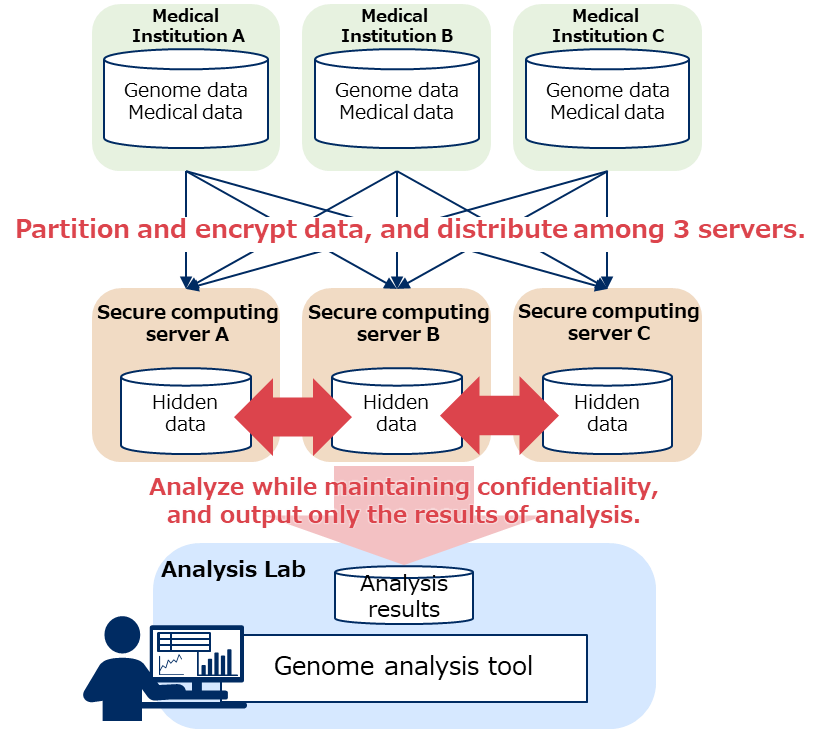News Releases & Research Results NEC and Osaka University demonstrate possibility of analyzing genome information from multiple institutions with reduced risk of privacy infringement using secure computation of encrypted data
News Releases & Research Results
Tokyo & Osaka, July 23, 2019 - NEC Corporation (NEC; TSE: 6701) and the research group of Akihiro Nakaya, Specially Appointed Professor (Full time), Graduate School of Medicine, Osaka University, under the Genome Informatics Joint Research Chair held in cooperation with Professor Yasushi Matsumura, Department of Medical Informatics, Faculty of Medicine, Osaka University, conducted trials to apply secure computation (*1), which enables the analysis of data in its encrypted state, to a genome analysis system. They demonstrated the practicality of a tool that allows analysts to use their own analysis methods in secure computation and showed that computation processing can be carried out at a practical speed, making it possible to perform genome analysis with minimized risk of privacy infringement, thereby contributing to the progress of research on personalized medicine.
In recent years, genome analysis aimed at elucidating relationships between genomes and diseases is gaining momentum in the efforts to develop effective medicines based on a person’s genome information. Since the data used in the analysis, however, involves highly confidential personal information, sharing of data among medical and research institutions has been a challenge.
The ability to perform various computational processing procedures on data in its encrypted state through secure computation has made it a promising method for confidentially combining and analyzing genome and disease information from multiple medical and research institutions. Conventional secure computation, however, has been deemed difficult to apply in genome analysis because of its computational complexity, which makes processing extremely slow and development of systems difficult to carry out.
NEC and Osaka University have applied NEC’s high-speed secure computation and development support tools into Osaka University’s genome analysis operations to demonstrate the possibility of performing genome analysis safely within a practical time frame.
In particular, NEC’s secure computation was applied to Osaka University’s analysis application, DS Viewer(*2), which combines and analyzes genome and disease information from multiple medical and research institutions, to confidentially collect such information and analyze the frequency of genomic variations. Further, analysis was carried out in such a way that tabulation results were disclosed only when more than a certain number of records were found to match given conditions to prevent the infringement of privacy (*3).

An analysis of the frequency of genomic variations by age showed that it was possible to combine and analyze the genome data of approximately 8,000 persons from different research institutions in around 1 second. This demonstrates that confidentially combining and analyzing genome and disease data is possible within a practical time frame, without disclosing the data to other research institutions.
In addition, results of the trials showed that using NEC’s development support tools (*4) for secure computation to implement Osaka University’s proprietary analysis algorithm (*5) enabled ordinary system engineers to complete the embedding of secure computation, which otherwise takes experts one month, within only a few days. This opens up various possibilities for applying secure computation to genome analysis.
NEC and Osaka University will move forward with further trials in applying secure computation to genome analysis. Through these efforts, both hope to contribute to the progress of cutting-edge medicine, including research on personalized treatments, by enabling medical and research institutions to mutually make use of their confidentially held genome and medical information, while protecting the privacy of patients.
This research was carried out with the support of the “Development of Clinical Genome Database of Dementia Project” in the "Program for an Integrated Database of Clinical and Genomic Information" under the Japan Agency for Medical Research and Development (AMED).
***
- (*1)
- A method developed by NEC in 2016 that drastically improves the speed of processing encrypted information through appropriate distribution of confidential information in a 3-server configuration.
Press Release: “NEC accelerates secure computing for reliable prevention of data breaches” (December 15, 2016) - https://www.nec.com/en/press/201612/global_20161215_02.html
- (*2)
- DS Viewer: A genome analysis application developed by the research group of Specially Appointed Professor Akihiro Nakaya. Genome data from Niigata University Brain Research Institute, National Center for Geriatrics and Gerontology Medical Genome Center, and Keio University School of Medicine were combined to carry out statistical analysis of genomic variations by gender, age, etc. under the Japan Agency for Medical Research and Development (AMED) Program for an Integrated Database of Clinical and Genomic Information “Development of Clinical Genome Database of Dementia Project” (Leader: Hiroshi Mori, Specially Appointed Professor, Department of Clinical Neuroscience, Graduate School of Medicine and Faculty of Medicine, Osaka City University).
- (*3)
- Detailed tabulation of information under different conditions generally leads to a small number of relevant data, leading to the possibility of inferring private information. For example, if there is only one person corresponding to a certain age and gender within a certain statistical population, tabulating the genomic variation frequency for that particular age and gender would allow inferring that person’s genomic variation data, which could lead to an infringement of privacy. It is therefore necessary to implement measures that prevent tabulation when finding less than a certain number of relevant data.
- (*4)
- A support tool developed by NEC in 2018 that facilitates the development of systems embedded with secure computation through the use of ordinary programming language.
- (*5)
- A proprietary analysis algorithm wherein regions with similar genomic variation patterns occurring continuously are expressed as blocks to streamline genome analysis.
For more information
About NEC Corporation
NEC Corporation is a leader in the integration of IT and network technologies that benefit businesses and people around the world. The NEC Group globally provides "Solutions for Society" that promote the safety, security, efficiency and equality of society. Under the company’s corporate message of “Orchestrating a brighter world,” NEC aims to help solve a wide range of challenging issues and to create new social value for the changing world of tomorrow. For more information, visit NEC at http://www.nec.com.
About Osaka University
Originating from Kaitokudo and Tekijuku, two places of learning established in Osaka during the Edo period, Osaka University was founded in 1931 as Japan’s sixth imperial university through strong demand from Osaka citizens and the government and business sectors of Osaka. Currently comprising 11 faculties, 16 graduate schools, and 6 research institutes, Osaka University continues to develop as a leading comprehensive research university. In line with its key concept, “Co-creation” with society, Osaka University conducts creative activities in cooperation with society with the goal of becoming a “World-Leading Innovative University Contributing to Social Change” by 2031, when it is to celebrate the 100th anniversary of its founding. For more information, go to http://www.osaka-u.ac.jp/en/
About Japan Agency for Medical Research and Development
AMED was established in April 2015 to catalyze the process of medical innovation and overcome the barriers between sectors, connecting talented individuals to accelerate medical research and development. Since then, significant gains in the fight against many diseases have been made.
07/24/19
Last updated 07/24/19

